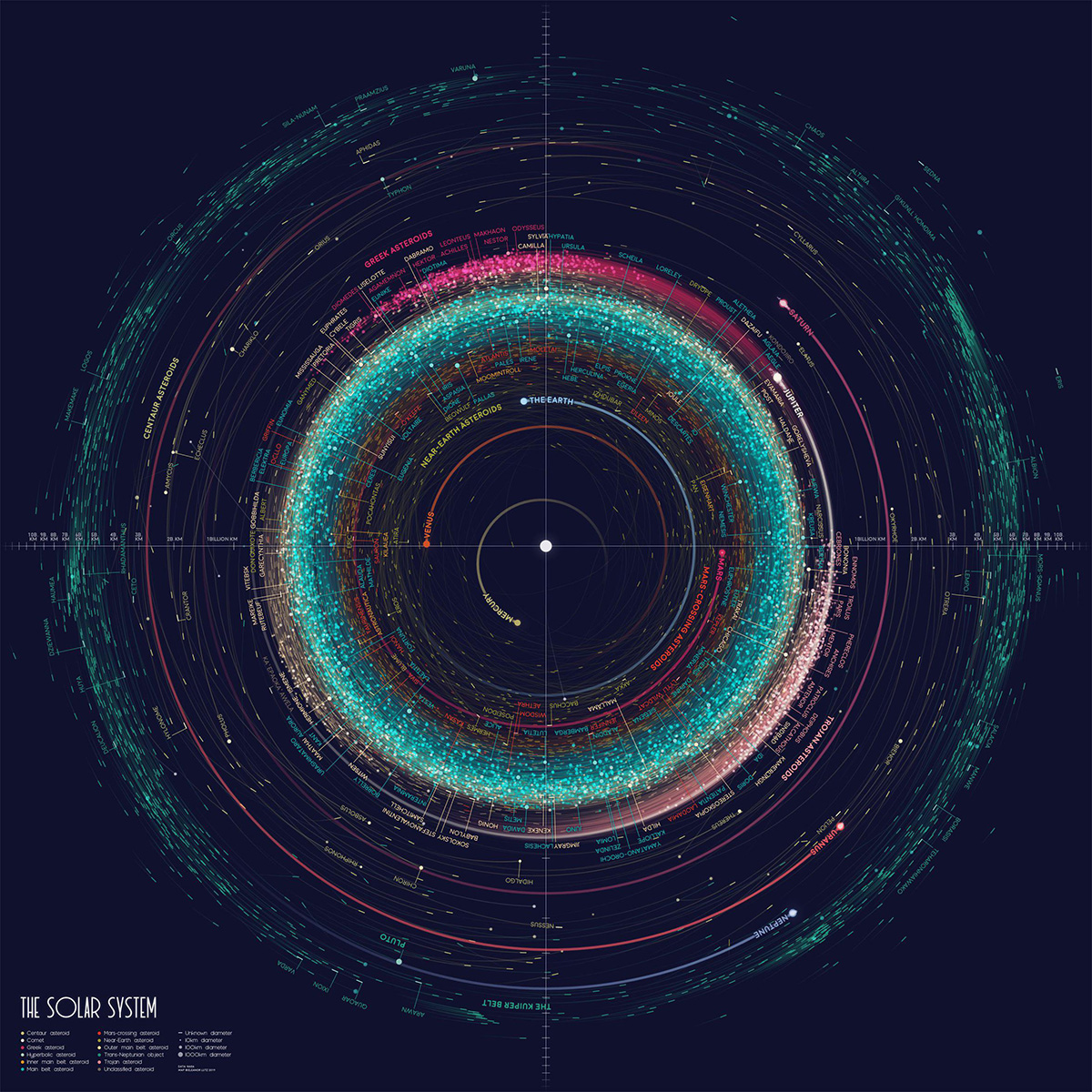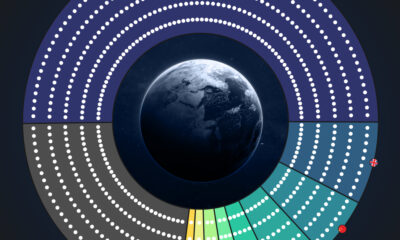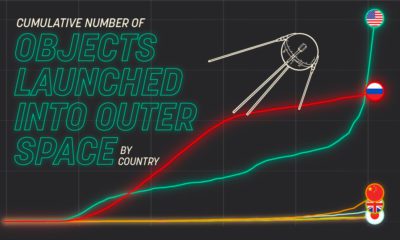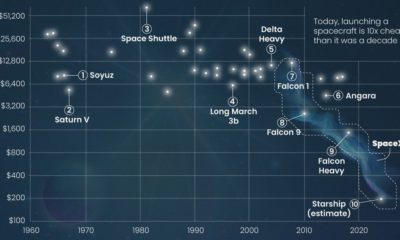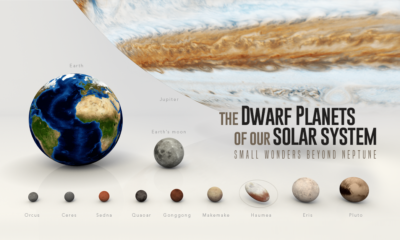Misc
A Map of Every Object in Our Solar System
View the full-size version of this infographic.
A Map of Every Object in Our Solar System
View the high resolution version of this incredible map by clicking here
The path through the solar system is a rocky road.
Asteroids, comets, planets and moons and all kinds of small bodies of rock, metals, minerals and ice are continually moving as they orbit the sun. In contrast to the simple diagrams we’re used to seeing, our solar system is a surprisingly crowded place.
In this stunning visualization, biologist Eleanor Lutz painstakingly mapped out every known object in Earth’s solar system (>10km in diameter), hopefully helping you on your next journey through space.
Data-Driven Solar System
This particular visualization combines five different data sets from NASA:

Source: Tabletop Whale
From this data, Lutz mapped all the orbits of over 18,000 asteroids in the solar system, including 10,000 that were at least 10km in diameter, and about 8,000 objects of unknown size.
This map shows each asteroid’s position on New Year’s Eve 1999.
The Pull of Gravity
When plotting the objects, Lutz observed that the solar system is not arranged in linear distances. Rather, it is logarithmic, with exponentially more objects situated close to the sun. Lutz made use of this observation to space out their various orbits of the 18,000 objects in her map.
What she is visualizing is the pull of the sun, as the majority of objects tend to gravitate towards the inner part of the solar system. This is the same observation Sir Isaac Newton used to develop the concept of gravity, positing that heavier objects produce a bigger gravitational pull than lighter ones. Since the sun is the largest object in our solar system, it has the strongest gravitational pull.
If the sun is continually pulling at the planets, why don’t they all fall into the sun? It’s because the planets are moving sideways at the same time.
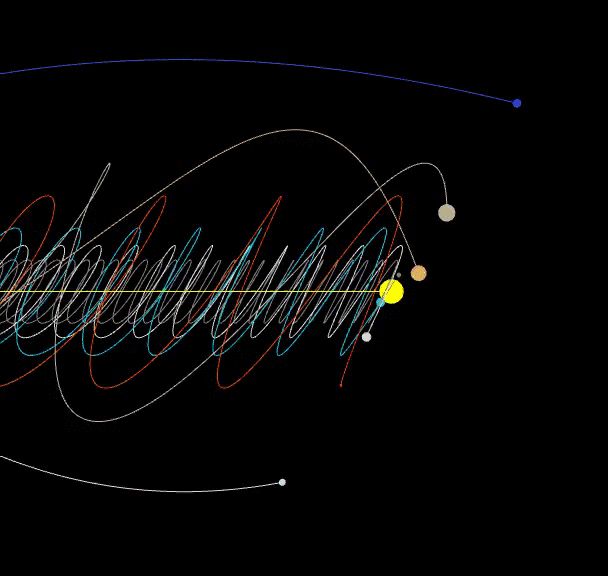
Without that sideways motion, the objects would fall to the center – and without the pull toward the center, it would go flying off in a straight line.
This explains the clustering of patterns in solar systems, and why the farther you travel through the solar system, the bigger the distance and the fewer the objects.
The Top Ten Non-Planets in the Solar System
We all know that the sun and the planets are the largest objects in our corner of the universe, but there are many noteworthy objects as well.
| Rank | Name | Diameter | Notes |
|---|---|---|---|
| 1 | Ganymede | 3,273 mi (5,268 km) | Jupiter's largest moon |
| 2 | Titan | 3,200 mi (5,151 km) | Saturn's largest moon |
| 3 | Callisto | 2,996 mi (4,821 km) | Jupiter's second largest moon |
| 4 | Io | 2,264 mi (3,643 km) | Moon orbiting Jupiter |
| 5 | Moon | 2,159 mi (3,474 km) | Earth's only moon |
| 6 | Europa | 1,940 mi (3,122 km) | Moon orbiting Jupiter |
| 7 | Triton | 1,680 mi (2,710 km) | Neptune's largest moon |
| 8 | Pluto | 1,476 mi (2,376 km) | Dwarf planet |
| 9 | Eris | 1,473 mi (2,372 km) | Dwarf planet |
| 10 | Titania | 981 mi (1,578 km) | Uranus' largest moon |
Source: Ourplnt.com
While the map only shows objects greater than 10 kilometers in diameter, there are plenty of smaller objects to watch out for as well.
An Atlas of Space
This map is one among many of Lutz’s space related visualizations. She is also in the process of creating an Atlas of Space to showcase her work.
As we reach further and further beyond the boundaries of earth, her work may come in handy the next time you make a wrong turn at Mars and find yourself lost in an asteroid belt.
“I knew I shoulda taken that left turn at Albuquerque!”
Misc
Visualizing the Most Common Pets in the U.S.
Lions, tigers, and bears, oh my!—these animals do not feature on this list of popular American household pets.

Visualizing The Most Common Pets in the U.S.
This was originally posted on our Voronoi app. Download the app for free on iOS or Android and discover incredible data-driven charts from a variety of trusted sources.
In this graphic, we visualized the most common American household pets, based on 2023-2024 data from the American Pet Products Association (accessed via Forbes Advisor).
Figures represent the number of households that own each pet type, rather than the actual number of each animal. The “small animal” category includes hamsters, gerbils, rabbits, guinea pigs, chinchillas, mice, rats, and ferrets.
What is the Most Popular American Household Pet?
Based on this data, dogs—one of the first domesticated animals—are the most common pets in the United States. In fact, around 65 million households own a dog, and spend an average of $900 a year on their care.
| Rank | Species | Households |
|---|---|---|
| 1 | 🐶 Dog | 65M |
| 2 | 🐱 Cat | 47M |
| 3 | 🐟 Freshwater Fish | 11M |
| 4 | 🐰 Small Animals | 7M |
| 5 | 🐦 Bird | 6M |
| 6 | 🦎 Reptile | 6M |
| 7 | 🐴 Horse | 2M |
| 8 | 🐠 Saltwater Fish | 2M |
Note: Households can own multiple pets, and are counted for all relevant categories.
Cats rank second, at 47 million households, and these smaller felines are a little less expensive to own at $700/year according to Forbes estimates.
But aside from these two juggernauts, there are plenty of other common pet types found in households across the country.
Freshwater fish can be found in 11 million households, along with small animals—rabbits, hamsters, guinea pigs—in 7 million. Meanwhile, nearly 6 million homes have birds or reptiles.
Pet Ownership is on the Rise in America
Forbes found that 66% of all American households (numbering 87 million) own at least one pet, up from 56% in 1988. One third of these (29 million) own multiple pets.
A combination of factors is driving this increase: rising incomes, delayed childbirth, and of course the impact of the pandemic which nearly cleared out animal shelters across the globe.
America’s loneliness epidemic may also be a factor. Fledgling research has shown that single-individual households with pets recorded lower rates of loneliness during the pandemic than those without a pet.
-

 Science1 week ago
Science1 week agoVisualizing the Average Lifespans of Mammals
-

 Markets2 weeks ago
Markets2 weeks agoThe Top 10 States by Real GDP Growth in 2023
-

 Demographics2 weeks ago
Demographics2 weeks agoThe Smallest Gender Wage Gaps in OECD Countries
-

 United States2 weeks ago
United States2 weeks agoWhere U.S. Inflation Hit the Hardest in March 2024
-

 Green2 weeks ago
Green2 weeks agoTop Countries By Forest Growth Since 2001
-

 United States2 weeks ago
United States2 weeks agoRanked: The Largest U.S. Corporations by Number of Employees
-

 Maps2 weeks ago
Maps2 weeks agoThe Largest Earthquakes in the New York Area (1970-2024)
-

 Green2 weeks ago
Green2 weeks agoRanked: The Countries With the Most Air Pollution in 2023

